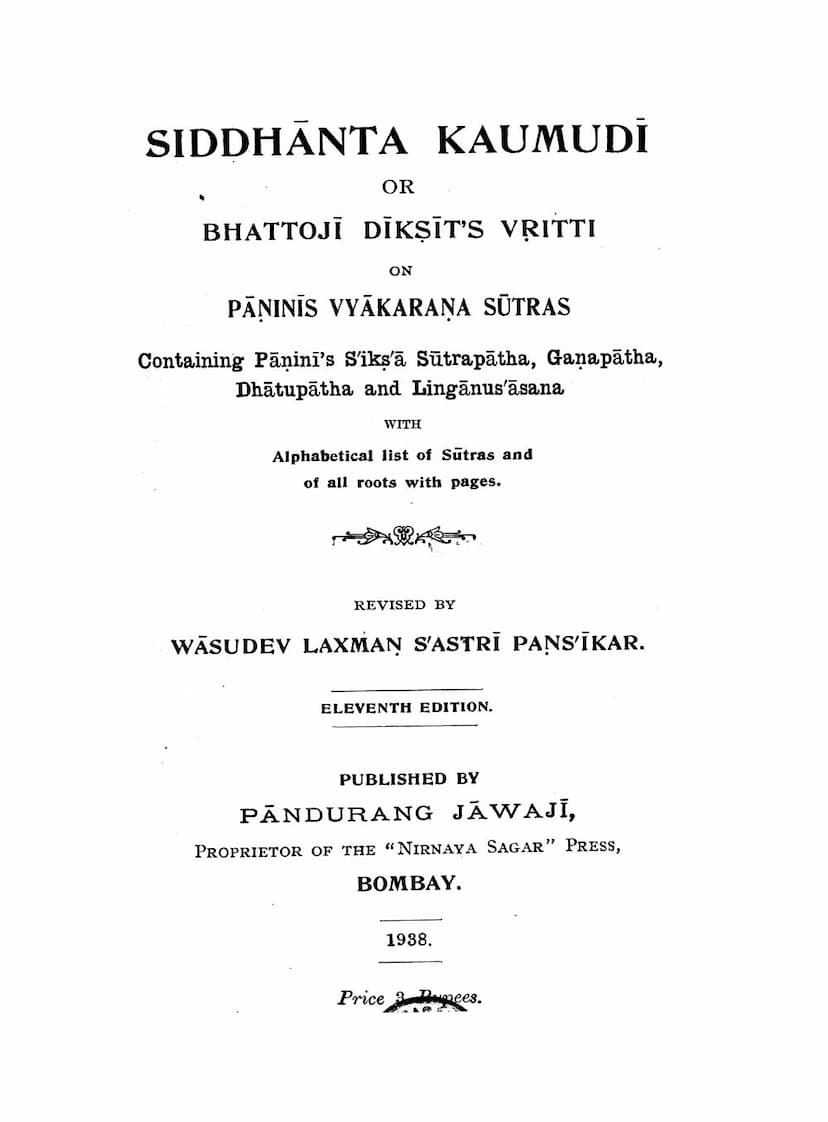Vaiyakaran Siddhant Kaumudi
Added to library: September 2, 2025

Summary
The provided text is the "Vyakaran Siddhant Kaumudi" by Vasudev Lakshman Shastri, published by Pandurang Jawaji in Bombay in 1938. This particular excerpt, identified as a Jain text for private and personal use, is a revised edition of Bhattoji Dikshit's Vritti on Panini's Vyakarana Sutras.
This excerpt focuses on the "Sangya Prakarana" (Chapter on Terminology) and "Sandhi Prakarana" (Chapter on Euphony) of Panini's grammar, along with introductory blessings and the Maheshwara Sutras.
Here's a breakdown of the key concepts covered in the provided pages:
1. Introduction and Blessings:
- The book is dedicated to the Munis (ancient grammarians) and is presented as a compilation of their teachings.
- It begins with an invocation to Lord Ganesha (Shri Ganeshaya Namah).
2. Maheshwara Sutras:
- The text lists the 14 Maheshwara Sutras (अइउण्, ऋलक्, एओङ्, ऐऔच, हयवरट्, लण्, अमङणनम्, झभञ्, घढधष्, जबगडदश, खफछठथचटतव्, कपय, शषसर, हलू).
- It explains their purpose: to derive the "sanjnas" (technical terms) related to vowels and consonants (अणादि-संज्ञा-अर्थानि).
3. Key Grammatical Concepts (Sangya Prakarana):
- It-samjña (Mit-samjña): The concept of sounds becoming "it" (represented by the final consonant of a sutra) and their subsequent elision (लोपः) is introduced with sutras like "halantyam" (हलन्त्यम्) and "ādir antyena sahetā" (आदि रन्त्येनेत्यादि). This is crucial for understanding how sounds are grouped into "pratyāhāras."
- Upa-deśa (Upadeśa): The meaning of "upadesha" is explained as the initial pronunciation (आद्योच्चारणम्).
- Svara-saṃjñā (Vowel Classification): The text delves into the classification of vowels based on duration:
- Hrasva (Short): (ऊकालोऽज्झ्रस्वदीर्घप्लुत: ऊकालोऽज्झ्रस्वदीर्घप्लुत:)
- Dīrgha (Long):
- Pluta (Extended):
- Udātta, Anudātta, and Svarita: The three types of pitch for vowels are explained with their respective phonetic locations (तालु, दन्ताः, ओष्ठौ etc.) and the concept of "samāhāraḥ svaritaḥ" (समाहारः स्वरितः - the combined sound being svarita).
- Savarga (Savarna - Homorganic Sounds): The definition of "savarga" is given based on identical articulation points (स्थान) and internal efforts (आभ्यन्तर प्रयत्न). This includes the specific articulation points for various sounds (कण्ठः, तालु, मूर्धा, दन्ताः, ओष्ठौ, नासिका च, कण्ठतालु, कण्ठोष्ठम्, दन्तोष्ठम्).
- Abhyāntara Prayatna (Internal Effort): The four types of internal effort are mentioned: "spṛṣṭa" (स्पृष्ट - touching), "īṣat-spṛṣṭa" (ईषत्स्पृष्ट - slightly touching), "vivṛta" (विवृत - open), and "saṃvrta" (संवृत - closed). The text specifies which sounds possess which efforts (e.g., sparśas are spṛṣṭa, antaḥsthās are īṣat-spṛṣṭa, ūṣmāṇas and vowels are vivṛta).
- Bahya Prayatna (External Effort): The eleven external efforts are listed: vivāra (विवार), saṃvāra (संवार), śvāsa (श्वास), nāda (नाद), ghoṣa (घोष), a-ghoṣa (अघोष), alpaprāṇa (अल्पप्राण), mahāprāṇa (महाप्राण), udātta (उदात्त), anudātta (अनुदात्त), and svarita (स्वरित). The text then elaborates on these for consonants.
- Taparaskara (T-kara for Duration): The sutra "tapasas takālasya" (तपरस्तत्कालस्य) is explained, emphasizing that the "t" in "taparaskara" signifies the precise duration of the sound "a" (तत्कालस्य) and not just any "a."
- Vr̥ddhi and Guṇa: The formation of "vr̥ddhi" (वृद्धि) and "guṇa" (गुण) sounds is introduced with the respective sutras "vr̥ddhirādaic" (वृद्धिरादैच्) and "adeṅ guṇaḥ" (अदेङ् गुणः).
- Dhātu (Root): The definition of a "dhātu" (root) is provided as "bhuvādayo dhātavaḥ" (भूवादयो धातवः) which encompasses roots like "bhū" (to be) and others listed from the Bhu class.
- Nipāta (Indeclinables): The text briefly touches upon "nipātas" (indeclinables) with sutras like "chādayo'sattve" (चादयोऽसत्त्वे) and "prādayaḥ" (प्रादयः), indicating their role in meaning conveyance.
- Upsarga (Prefixes): Prefixes like "pra," "parā," "apa," etc., are introduced with the sutra "upasargāḥ kriyāyoge" (उपसर्गाः क्रियायोगे).
- Samhitā and Avsāna: The definitions of "saṃhitā" (close juxtaposition of sounds) and "avasaana" (cessation of sound) are given ("paraḥ saṃnikarṣaḥ saṃhitā" - परः संनिकर्षः संहिता and "virāmo'vasānam" - विरामः अवसानम्).
- Padasaṃjñā (Word): "Subanta" (words ending in sup-affixes) and "tiṅanta" (words ending in tiṅ-affixes) are defined as "pada" (पद).
- Saṃyoga (Conjunct): Consecutive consonants not separated by vowels are defined as "saṃyoga" (संयोग).
- Laghu and Guru: The concepts of "laghu" (light syllable) and "guru" (heavy syllable) are explained, with the rule that a syllable becomes "laghu" in "saṃyoga" (संयोगे गुरु).
4. Definitions and Rules:
- The text highlights the importance of various rules of interpretation (परिभाषा), such as "tasminnniti nirdiṣṭe pūrvasya" (तस्मिन्निति निर्दिष्टे पूर्वस्य - in what is indicated by a seventh case, the preceding element), "tasmādityuttarasya" (तस्मादित्युत्तरस्य - from that, the following), "alo'ntyasya" (अलोऽन्त्यस्य - the last element of a group), "ādeḥ parasya" (आदेः परस्य - the first element of a group), "anekāl śitsarvasya" (अनेकं शित् सर्वस्य - what is indicated by a word containing 'ś' or 'i' has manifold elements and applies to the whole), and "sthāne'ntaratamaḥ" (स्थानेऽन्तरतमः - the nearest substitute).
- The rule of "asid'dha" (असिद्ध) in Panini's grammar is also mentioned, stating that the rules of the latter three "pādas" (quarters of the grammar) are ineffective in the preceding "pādas."
In essence, this excerpt from the "Vyakaran Siddhanta Kaumudi" serves as a foundational introduction to Sanskrit grammar, defining core terminology, phonetic rules, and the systematic structure laid down by Panini. The revised edition by Vasudev Lakshman Shastri aims to present this complex knowledge clearly.